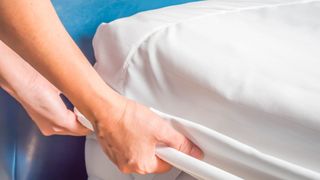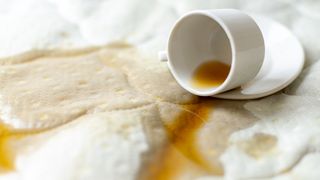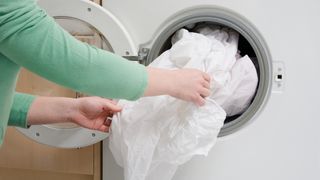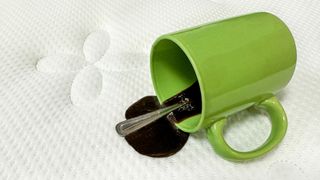
When you purchase through links on our site, we may earn an affiliate commission. Here’s how it works.

The best way to prolong the life of your mattress is to invest in a waterproof mattress protector. Whether you're going to buy one or you already have one, knowing how to wash and dry a waterproof mattress protector is important because they vary slightly (in terms of care) from standard protectors.
Buying the best mattress for your sleep needs and body type is a big investment, so a waterproof mattress protector that sits on top of your mattress to shield it from spills, accidents, dust mites and allergens is a vital purchase.
While many bed protectors can be machine washed and dried alongside the rest of your bedding, there are a few do’s and don’ts that you need to be aware, particular with waterproof protectors. Here's what you need to know.
A waterproof mattress protector is a fitted sheet-like piece of bedding that sits over the top of your mattress and underneath your bottom sheet. The best mattress protectors provide a barrier between you and your mattress so any accidents, spills, sweat, allergens, and dust mites don’t get onto the mattress and cause stains, odors, and damage.
The big difference between waterproof mattress protectors and standard mattress protectors is down to fabric that they’re made from and how they handle liquids. Waterproof mattress protectors typically have a thin layer of polyurethane or similar material that acts as a barrier to liquids. Where are standard mattress protectors are made from quilted fabrics like cotton or polyester blends.

Waterproof mattress protectors are a really good idea for households with children, pets, or those prone to accidents and spills. Waterproof mattress protects don’t just stop your mattress from getting wet, but they can also help to prevent mold growth and the spread of dust mites.
When you’re looking at mattress protectors, you may notice that some claim they are water resistant whilst others claim they’re waterproof. Just be aware that water resistant means that some liquid may seep through, this won’t be too much of an issue if you’re able to act quickly in the event of any spills, but if you’re dealing with accidents on a regular basis then these may not be the best option.
Get instant access to breaking news, the hottest reviews, great deals and helpful tips.
By submitting your information you agree to the Terms & Conditions and Privacy Policy and are aged 16 or over.
Instead look for waterproof mattress protectors, as waterproof means that there is usually a thin layer of plastic in the middle of the protector which stops any liquid from soaking through. We explain more in our guide on how to choose a mattress protector for bed bugs, dust mites, urine, mold and more.
It’s important to make sure that you have a mattress protector on your bed. They offer fantastic protection and are relatively inexpensive too, at least they’re way cheaper than having to replace your mattress every couple of years.
If you’ve recently purchased a mattress and have a long warranty period, then it is worth checking the conditions of the warranty, because it’s likely that you’ll be required to have a mattress protector on your mattress for it to remain in place.
Waterproof mattress protectors can help to create a healthier sleep surface. As they will block any liquids from seeping into your mattress therefore preventing the growth of mold, mildew, and bacteria that thrive in such humid, damp environments. Plus, they can help stop unsightly stains and odors that happen over time.

Waterproof mattress protectors can also create an allergy and dust-mite barrier. If you wake in the morning and find that you’re snuffy or have itchy skin or eyes, it could be your mattress that’s making you sick. Waterproof mattress protectors are often made from material that stops allergens and dust mites from getting into the fibers of your mattress which often trigger asthma and allergies.
There are a couple of downsides associated with waterproof mattress protectors. They can be a nightmare for those who sleep hot, because the waterproof layer can trap heat which then gets pushed back out overnight.
Waterproof mattress protectors can also be noisy, because the material used may make a crinkling noise when you move around which may disturb light sleepers. Here are our top three recommendations for waterproof mattress protectors.
1. Coop Home Goods Waterproof Mattress Protector: From $46 at Amazon
In the US, the Coop Home Goods Mattress Protector topped our list on the roundup of the best mattress protectors. This protector is made from hypoallergenic materials and is even suitable for hot sleepers. A queen size will cost you $59 on Amazon. It’s also available for sale in the UK with a king size version costing £83 at Amazon.
2. Purple Waterproof Mattress Protector: From $79 at Purple
The machine washable Purple Mattress Protector is also waterproof and can fit mattresses up to 15 inches deep. It is made from a blend of polyester and spandex so it will fit your bed well. This mattress protector is also stain resistant and has a dust mite and dander barrier. A queen size costs $99 from Purple with free shipping.
3. OTTY Waterproof Mattress Protector: From £89.99 at OTTY
UK readers can get some great deals on waterproof mattress protectors from outlets including John Lewis, Soak&Sleep, and Dreams. Mattress manufacturer OTTY has a microfiber mattress protector that isn’t just waterproof but also breathable and hypoallergenic. A king size costs £119.00 from OTTY.
The great thing about waterproof mattress protectors is that they’re easy to clean. However, to avoid damaging your mattress protector, it’s important to make sure you wash it right.
Always check the care label for specific instructions, these can vary by manufacturer but also are dependant on the type of material used. One thing with waterproof mattress protectors is that it’s not recommend that they get dry cleaned, this is due to the high heat used during that process which can ruin the waterproof materials.
If you mattress protector has any stains then you may want to sort these first. You can use a commercial pre-treatment so long as it’s suitable for the type of material you are working with. Or you could get a pray bottle and mix together one part water with one part vinegar and a dash of mild detergent. Spray this on the affected area and rub the cover to work out the stain.
Most waterproof mattress protectors can be machine washed so add this to your machine. It’s best to avoid overloading the machine at this point and because there’s plastic in the waterproof mattress protector, avoid placing in with any other clothes or bedding.

Be sure to use around 1/4 of what you normally use when washing clothes as too much detergent can cause a build-up of residue on the fabric. Also, avoid using fabric softeners as this can cause damage to the waterproof layer.
It’s important not to use hot water on your mattress protector. Stick to a delicate cycle and lukewarm water so around 30 degrees. This will still clean your mattress protector and get rid of any stains and bacteria lingering, but the cooler temperatures will ensure it doesn’t get misshapen or damaged.
If your mattress protector is delicate and the care instructions say you can’t put in the washing machine then fill a bathtub with lukewarm water and add a couple of drops of mild detergent. Submerge the protector and gentle agitate it to remove any dirt, debris and stains. Then rinse thoroughly in clean water making sure to move all the soap residue.
Before you set about drying your waterproof mattress cover, again just check the care label to ensure that you’re following the manufacturer’s instructions.
✅ 1. Do tumble dry it on low: Most waterproof mattress protectors can be machine dried. However, use the lowest heat setting possible so not to damage the waterproof membrane.
✅ 2. Do line dry it: If the weather is good then hang your protector out on the line. However, if you have allergies, you may want to reconsider this method as often allergens can stick to the damp clothing whilst it’s on the line and trigger allergy symptoms. Don’t hang your mattress protector in direct sunlight as this may cause a bleaching effect to the fabric.
❌ Don’t iron your waterproof mattress protector: The high heat can damage the waterproof layer and render it useless.
❌ Don’t wash your mattress protector too often: Of course, the frequency you wash it will depend on the usage but try to limit this to around every two to three months to keep it hygienic without adding additional wear.
Just like mattresses, waterproof mattress protectors don’t last forever – if yours is over five years old, it could be time that you upgrade. If you look after your mattress protector then you’ll get a good few years out of it, but here are six signs to look out for when it’s time to replace it.
1. There's obvious damage: Wear and tear happens, especially if you’re sleeping on it night after night. But keep an eye out for any holes and rips as this can compromise the mattress protectors ability to block liquids.
2. You've noticed worn spots: If you see any excessive thinning or worn areas, it’s time to bin it and get a new one. You’ll usually spot these around pressure point areas.

3. Liquids seep through: If your mattress protector is labeled as water resistant then you may notice some liquid seeps through. However, this shouldn’t be the case with a waterproof mattress protector. So if you’re noticing liquid coming through then get a new one before it damages your mattress.
4. It smells: If your mattress protector is starting to smell that could mean you have a milder or mold growth happening. This usually occurs when there is trapped moisture so for the good of your health, if you smell something bad, ditch it and treat yourself to a new one.
5. You’ve washed it too much: Washing your mattress protector too often can lead to increased wear and tear. A good workaround for this is to have a couple that you can rotate.
When it comes to finding a good waterproof mattress protector then there are a few things to consider. Firstly, think about whether you need waterproof or water resistant. Water resistant will just repel spills but won’t completely stop them from soaking in. Whilst waterproof, will offer the ultimate protection, this is a good choice for accidents, pets and young children.
Also think about how lightly you sleep. If you are a light sleeper then avoid protectors with noisy plastic materials as you’ll be disturbed just by moving about at night. It’s also worth looking at protectors with built-in allergen properties. These use tight woven fabrics to stop allergens and pests such as dust mites from entering and causing your irritation.
One of the biggest things that you should look for when choosing your waterproof mattress protector is the fit and depth. You need your protector to fit like a glove. If it’s too small then it may not provide full coverage, if its too big then it will ruffle up and become uncomfortable. Same goes for depth, if your mattress is 15-inches deep, find one that will cover it all. Take a look at your manufacturers’ website if you need help with the dimensions and depth of your mattress.